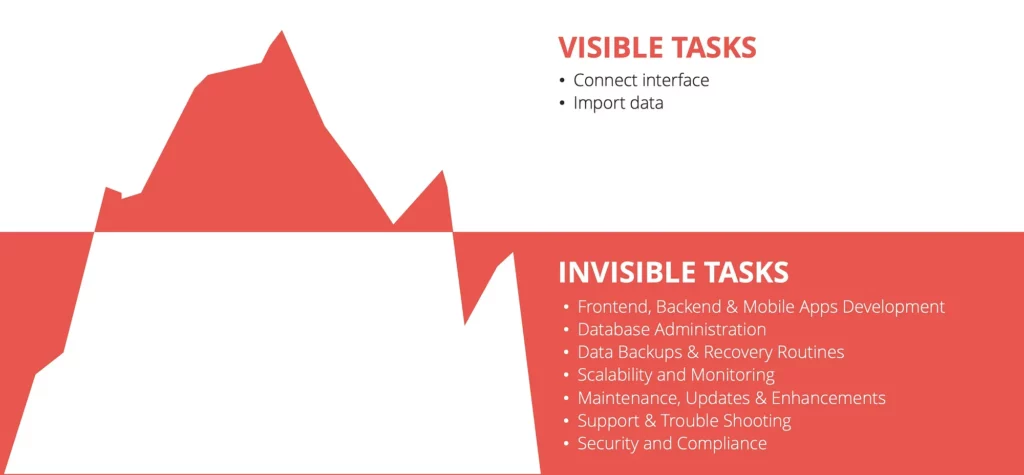-
Getting Started
-
Garmin Devices
-
Setup
-
Manage
-
Data Collection
- Collect Data: Synchronization Types
- Collect Data: Tablet Sync (multi-sync) with "Fitrockr Hub (Multi-Sync)" app
- Collect Data: Smartphone Sync (single-sync) with Garmin Connect app
- Collect Data: Overview
- Collect Data: Smartphone Sync (single-sync) with Fitrockr app
- Collect Data: Sync via USB cable to Laptop
- Collect Data: Smartphone Sync (single-sync) with Omron Blood Pressure Monitors
- Apple Health and Google Health Connect
-
Track
-
Analyze
-
Other
-
Trouble Shooting
-
Definitions
-
FAQ
-
Blog
Why API Integration Is Harder Than It Looks: The Iceberg of Invisible Tasks
When businesses or researchers set out to integrate a wearable web API—the task often appears deceptively simple. On the surface, it seems like all you need to do is “connect the interface” and “import the data”. This is the visible part of the work. However, like an iceberg, the bulk of the complexity lies beneath the surface—unseen but essential.
The image below illustrates this concept clearly: visible tasks are just the tip, while invisible tasks form the massive base of work required to ensure a secure, scalable, and reliable API integration.

Let’s break down these invisible tasks and why they are so critical:
Frontend, Backend & Mobile Apps Development
Integrating an API requires building or adapting the frontend (what users see), backend (server logic), and sometimes mobile apps. These components must be designed to handle new data structures, user flows, and error states. Simply calling an API is not enough—the entire user experience needs to be adapted and rigorously tested.
Database Administration
Fetched data must be stored somewhere. Designing the right schema, ensuring efficient queries, managing data integrity, and optimizing performance all fall under database administration. Poor planning here can lead to massive performance bottlenecks or data loss.
Data Backups & Recovery Routines
What happens if something goes wrong? Regular backups and recovery routines ensure that your data is not lost during a crash, bug, or attack. Setting up these processes is crucial but rarely considered until it’s too late.
Scalability and Monitoring
APIs might work well in a test environment or with limited users. But how will the system perform with 10x the data volume or users? Scalability planning ensures the system can grow, while monitoring allows early detection of performance or reliability issues.
Support & Troubleshooting
When something breaks—and it will—someone needs to identify the problem, debug it, and fix it. This often involves dealing with API rate limits, authentication errors, or unexpected data formats. Having proper logging and alerting in place is vital for quick response.
Security and Compliance
Wearable APIs deal with sensitive data—user health and personal information. Ensuring secure authentication, encryption, and compliance with regulations like GDPR or HIPAA is non-negotiable and requires deep expertise.
Conclusion: Don’t Be Fooled by the Tip of the Iceberg
API integration is not just about “connecting to an interface”. It involves an entire infrastructure of planning, development, testing, and long-term operations. Underestimating this can lead to project delays, security vulnerabilities, and a poor user experience.
Before considering Wearable API integration yourself, be sure to account for the full scope—including all the invisible tasks. Or better yet, consider working with us who can provide a plug-and-play solution at a fraction of the “build-yourself-cost”.
Feel free to contact us.